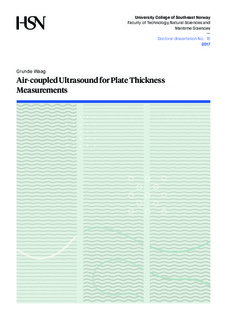| dc.contributor.author | Waag, Grunde | |
| dc.date.accessioned | 2017-04-28T10:53:34Z | |
| dc.date.available | 2017-04-28T10:53:34Z | |
| dc.date.issued | 2017 | |
| dc.identifier.isbn | 978-82-7860-299-7 | |
| dc.identifier.issn | 2464-2843 | |
| dc.identifier.uri | http://hdl.handle.net/11250/2441223 | |
| dc.description.abstract | Non-destructive testing using ultrasound is well established as a technique of inspecting miscellaneous structures and components. Ultrasonic waves propagating in an elastic solid are sensitive to both the material and geometrical properties of the solid. Decades of experience have shown that it is possible to extract these properties from the waves in an efficient and reliable way in a variety of practical measurement settings. Different techniques have been developed over many decades, and ultrasonic devices are now standard tools for conducting inspection in the oil and gas industry, infrastructure, aerospace industry, and many other fields.
One technique used to examine the properties of a material is based on the acoustic resonance in solid plates. When waves propagate in a plate with finite thickness, they are reflected multiple times within the plate. At some frequencies, this will create a resonance. The resonance frequencies depend, among other parameters, on the thickness of the plate, hence, measurements of the resonance frequencies is a means of determining the plate thickness.
Most ultrasound inspection techniques depend on a liquid coupling between the ultrasound transducers and the solid.
This thesis aims to assess the feasibility of using air-coupled ultrasound for thickness measurements of steel plates, by finding the thickness resonances in the plate. To achieve this, theoretical models for the wave propagation in the plate were developed, featuring the relation between resonances found in a real experimental situation, and the thickness and material parameters of the plate.
The main contributions are:
1. Experimental verification of through-transmission acoustic measurements on a steel plate in air, showing that it was possible to detect several plate resonances. These resonances were used to estimate the plate thickness, demonstrating that it was possible to distinguish between plate segments differing in thickness by 2%.
2. Implementation of a theoretical model to elaborate on the observations of the steel plate measurements. The model is based on the angular spectrum method, includ ing the effects of the finite apertures of the transducers; wave propagation in air and elastic waves in the solid plate. The interaction between the plate and the air is handled by plane wave reflection and transmission coefficients. The transducers are described by a plane piston-model.
3. A feasibility study of using a receiver displaced laterally away from the acoustical axis of the transmitter. The scope of the theoretical model was adjusted to include this situation, and then tested experimentally in a through-transmission study on a steel plate in water. The theoretical model was then used to investigate the possibility of conducting pulse-echo measurements on a steel plate in air, using a receiver displaced laterally off the transmitter’s acoustical axis. The purpose of this study was to avoid saturating the receiver from the strong first reflection from the air-steel interface, and detect the echoes from reverberations inside the plate.
4. A systematic, theoretical study of the position of the first resonance peak in the received spectra in the through-transmission setup described above. For certain parameter combinations, the first compressional resonance was found to be as low as 0.89 times the plate cut-off frequency, i.e. the simple plane wave assumption can result in errors of up to 11 % compared with the cut-off frequency of the S1- mode when estimating the plate resonance. A particular focus was on how the down-shift of this resonance depends on the angular spread of the sound field, and how it varies between different material types, especially as a function of the Poisson’s ratio of the material. | nb_NO |
| dc.language.iso | eng | nb_NO |
| dc.publisher | University College of Southeast Norway | nb_NO |
| dc.relation.ispartofseries | Doctoral dissertations at the University College of Southeast Norway;18 | |
| dc.relation.haspart | Paper A: Waag, G., Hoff, L. & Norli, P. (2015). Air-coupled ultrasonic through-transmission thickness measurements of steel plates. Ultrasonics, 56, 332-339. doi: https://doi.org/10.1016/j.ultras.2014.08.021 | nb_NO |
| dc.relation.haspart | Paper B: Waag, G., Hoff, L. & Norli, P. (2014). Feasibility of pulse-echo thickness measurements in air with a laterally displaced receiver. 2014 IEEE International Ultrasonics Symposium, 1029-1032. (Note: Paper in printed thesis is an extended version) | nb_NO |
| dc.relation.haspart | Paper C: Waag, G. & Hoff, L. (Submitted). Finite transducer aperture influence on spectra received after transmission through an elastic plate, at frequencies near the leaky S1 and S2 modes. NDT & E International. | nb_NO |
| dc.relation.haspart | Paper D: Waag, G. (Unpublished) Angular spectrum method implementation in MATLAB(r) [Technical manual, not for publication] | nb_NO |
| dc.subject | Ultrasound | nb_NO |
| dc.subject | Acoustics | nb_NO |
| dc.subject | Thickness-measurements | nb_NO |
| dc.title | Air-coupled ultrasound for plate thickness measurements | nb_NO |
| dc.type | Doctoral thesis | nb_NO |
| dc.subject.nsi | VDP::Matematikk og Naturvitenskap: 400::Fysikk: 430::Elektromagnetisme, akustikk, optikk: 434 | nb_NO |
| dc.source.pagenumber | 67 | nb_NO |
